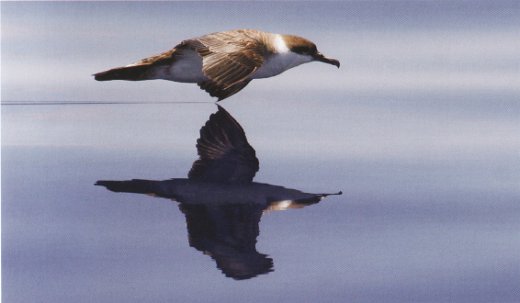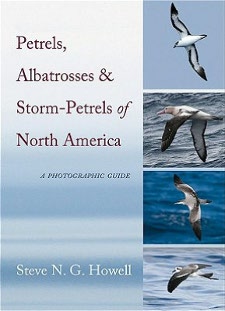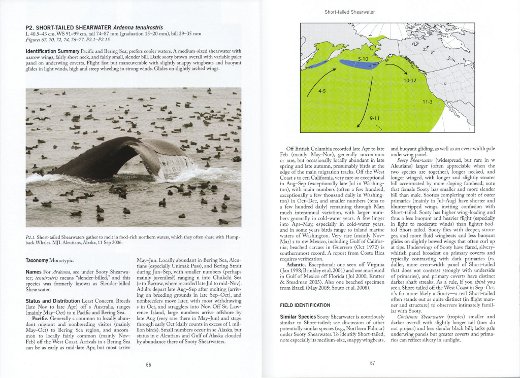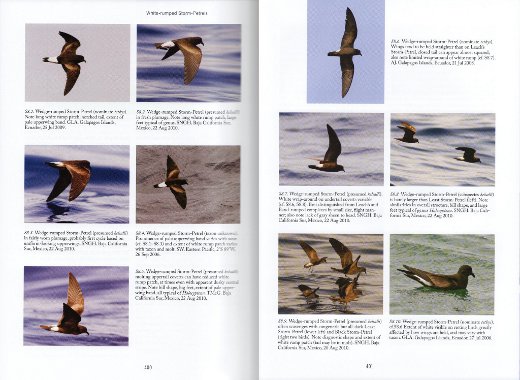Reviewed by Grant McCreary on March 24th, 2012.
“Wow!” That, or something similar but perhaps less fitting for a family website, is likely the most common reaction of someone seeing an albatross for the first time. Or, for that matter, Petrels, Albatrosses, and Storm-Petrels of North America: A Photographic Guide. First of all, this is one large, heavy book. And then, when opened, you’re greeted by a plethora of attractive photographs and detailed maps in a well-designed layout. But do the contents of this book live up to the favorable first impression?
Petrels, Albatrosses, and Storm-petrels of North America is a photographic identification guide to these birds (also called tubenoses) by Steve Howell, who is probably the foremost expert on their identification. These are not birds that you are likely to see from land. You have to make a concerted effort to see tubenoses, which usually means going on a boat (“pelagic”) trip. But it’s worth it. However, once you see them you will find that they are not the easiest birds to identify. Many look frustratingly alike, and when you compound that with the less-than-ideal viewing situations inherent to pelagic trips, you will understand why a book such as this one was desperately needed.
This guide includes all of the approximately 70 species that have been recorded in North America. That last sentence seems straightforward, but needs to be expounded upon a bit. First, it is “approximately 70 species” due to the dynamic taxonomic status of these birds. There are 70 accounts here, but some treat multiple taxa that could be distinct species. Second, Howell includes two birds – Solander’s Petrel and Madeiran Storm-petrel – that are assumed to occur here, but have yet to be confirmed. Last, “North America” means exactly that; this book’s geographic coverage is waters within 370 km (200 nautical miles) from land from Alaska and Canada south through the Caribbean to Panama.
The accounts are broken down into three sections: Petrels (including Shearwaters); Albatrosses; and Storm-Petrels. Each of these is further broken into subsections that group similar birds. Each section and subsection is preceded by an extremely helpful introduction that includes general identification tips and comparison photos.
Species Accounts
Each account includes:
- Size – length and wingspan in centimeters; bill and tail measurements where appropriate
- Identification Summary
- Taxonomy
- Names – origin of scientific and common names, if known (neat addition)
- Status and Distribution
- Similar Species
- Habitat and Behavior
- Description
- Hybrids
- Molt – wing molt timing, for the most part
Altogether, each account comprises one to four pages of text.
Large, detailed range maps are included for all regularly-occurring tubenoses, with colors representing breeding and at-sea ranges, and molting areas. Arrows indicate the direction of migration routes, with numbers giving the months of their occurrence. Birds that occur in both the Atlantic and Pacific have separate maps for each.
Photographs
Each account, save one, concludes with a series of photographs showing the bird in a range of positions and plumages. The lone exception is Townsend’s Shearwater, which is illustrated with a painting by Ian Lewington comparing Townsend’s with other small shearwaters. The photo captions highlight specific field marks and identification tips, and also include the photographer and the location and date the photo was taken.
Given the challenging conditions of pelagic photography, these photos are great. And some are truly spectacular, such as the Great Shearwater on page 5, which instantly became one of my favorite bird photographs ever (see below). But perhaps the most useful of all the photos are those that include multiple birds, of different species, which allows direct comparisons. I only wish there were more such pictures here.
The only other complaint I had about the pictures was that I felt they were too small and some didn’t show enough details, especially the aforementioned shots with multiple birds. However, after some feedback from others and spending some more time with the book, I no longer think this is a valid criticism. Yes, it would be nice if the pictures could be a bit larger, but even as they are they do an amazing job of depicting these birds as birders are likely to see them in the field.
Introduction
A 50-page introduction describes tubenoses, ocean habitats, taxonomy, conservation concerns, and field identification. The latter section, the largest at 21 pages, begins with a warning that “what follows may seem an almost overwhelming amount of information to digest”. And, indeed, it is intimidating. But Howell has a knack for taking even the most technical and arcane of subjects and making them understandable. This introduction, as well as the various introductory sections throughout the book, is worth reading and re-reading.
The main thing I can think of that would improve this guide would be to have Lewington illustrate every species. But, presumably, that’s being saved for the upcoming field guide that he’s working on (also with Howell, and others, for Princeton).
This book will obviously be of most help to North American birders, but it would be useful to western European birders as well since many of the birds covered can also be found in the eastern Atlantic.

Great Shearwater © Steve N. G. Howell
Recommendation
Petrels, Albatrosses, and Storm-Petrels of North America: A Photographic Guide is absolutely required for anyone interested in the identification of these wonderful birds, and is one of the best family identification guides, period. If you have ever been, are planning to go, or even think that you might someday go on a pelagic trip, then you should get this!
Disclosure: I get a small commission for purchases made through links in this post.
Disclosure: The item reviewed here was a complementary review copy provided by the publisher. But the opinion expressed here is my own, it has not been influenced in any way.







Comment